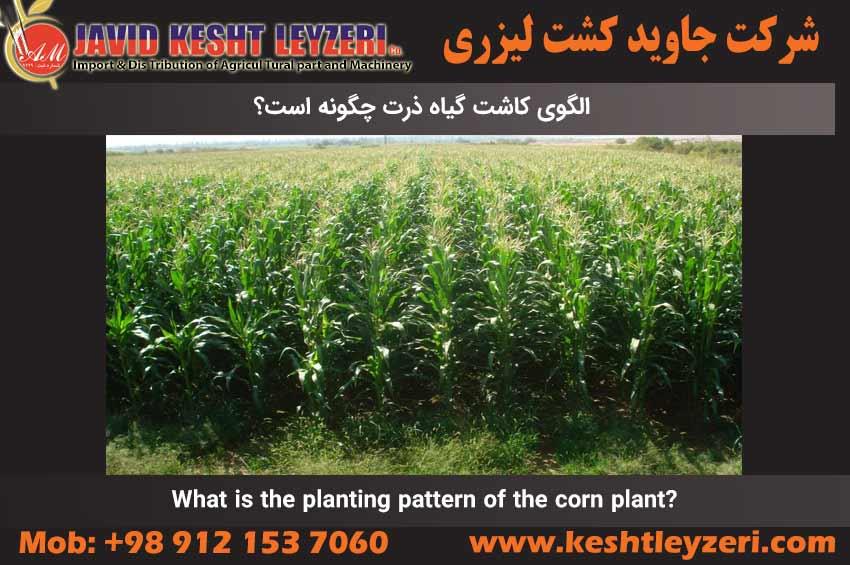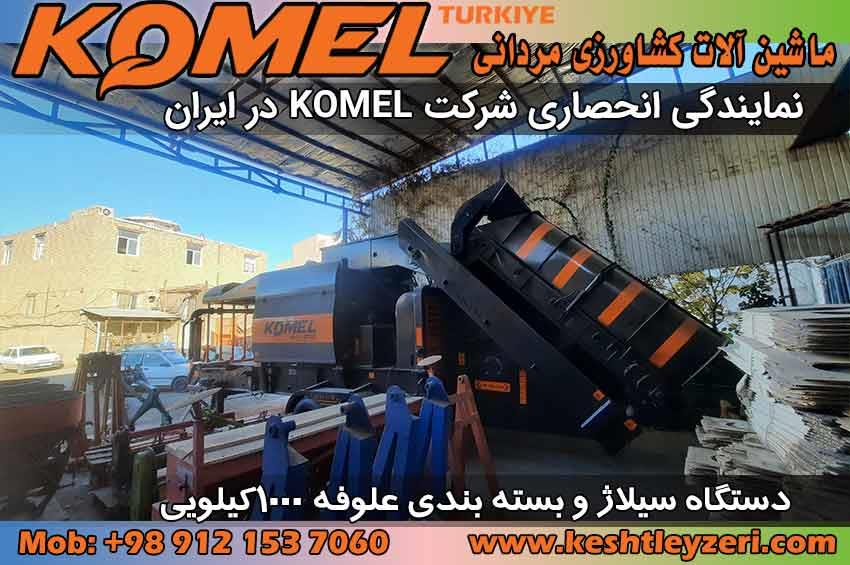
What is the planting pattern of the corn plant?
javid keshtleyzeri Co.ltd
What is the planting pattern of the corn plant?
What is the distance between corn planting rows?
What are the advantages of narrow row spacing in corn cultivation?
What are the disadvantages of narrow row spacing for planting corn?
How is the cultivation of two rows of corn?
How to choose the right variety for the row spacing of corn?
In the following, the above questions will be answered.
What is the planting pattern of the corn plant?
The corn plant performs best in tropical or temperate regions with sufficient light radiation. The type of soil suitable for planting corn is soft and relatively fertile soil with good drainage.
Corn planting is done directly or spatially with the help of seed planting mechanisms. The distance between the rows and between the plants should be such that it is possible to easily access the plants to perform cultivation operations, including watering, weeding and using fertilizers.
In the planting process, special attention should be paid to the proper planting depth and irrigation. Fertilizers and livestock poisons should also be used according to standard methods and at appropriate times.
Also, according to the needs of the plant, the right time to harvest corn should be taken into account and selected harvesting should be done in the correct way.
In general, the corn plant planting pattern relies on the above and requires special care and attention to be followed and optimized.
What is the distance between corn planting rows?
In the past, the distance between corn planting rows was determined based on the needs of animals to pass agricultural tools such as plows. But since the 1960s, cultivation began in narrower rows with a distance of 75 cm instead of 100 cm; Because research showed that this pattern increases the yield potential of corn.
Due to the increasing global population, research continues to compare the advantages and disadvantages of narrower rows. The proper distance between the rows and the observance of the cultivation pattern allow the plants to improve the nutrients and minimize the competition between different species.
Since crop performance is affected by environmental conditions, it is better for farmers to test new systems on their farm to improve its effect.
The width of corn rows has decreased over time. Most farmers use a width of 75 cm, but in some areas, a width of 40 or 50 cm is also used. Benefits of using narrower rows include uniform use of planting tools, reduced weed competition, and increased light and nutrient uptake by plants.
As the plant population grows each year (1,000 plants per hectare per year), using wide rows allows more plants to be concentrated in one area, while narrower rows allow for better dispersion.
Research shows that in areas with short growing seasons such as the northern states of the US Corn Belt, narrow rows can increase corn yield by 7%-10%. This advantage is due to the short growing season and the use of early corn in these areas. The use of early varieties of corn and narrow row spacing helps to reduce plant competition, optimize sunlight penetration and increase yield.
In relation to the Central Corn Belt, research has shown that narrow row spacing can lead to a slight increase in yield. For example, according to a report from Purdue University, the average yield increased by 2.7% when choosing a row spacing of 40 cm compared to a row spacing of 75 cm. Other results also show that the performance increases by 5% due to the use of narrow rows.
Research in other areas, including Iowa State University, has shown that row spacing of 40 cm and 75 cm in corn cultivation did not have a significant effect on corn yield. However, it is important to note that using narrow row spacing does not result in reduced performance.
In order to more closely examine the effects of reducing row spacing in corn cultivation, many comparative studies have been conducted in connection with various types of row spacing in single-row and double-row cultivation.
In a study, it was found that double row cultivation with twin row spacing of 75 cm and single row cultivation with 90 cm spacing both had better performance than single rows of 40 and 75 cm.
In another similar study in Mississippi, a comparison was made between two commercial cultivars in one row with a distance of 75 and 100 cm with two rows with a distance of 100 cm. The results of this study showed that the distance of 75 cm had the highest performance potential. On the other hand, other researches have also shown that investigating the performance response of a double-row corn production system with 17-20 cm spacing between two twin rows compared to single-row corn cultivation with 75 cm spacing did not have a significant effect on the performance. Therefore, the selection of maize cultivar and plant population is of particular importance and can have a significant effect on yield.
What are the advantages of narrow row spacing in corn cultivation?
Potential benefits of narrow row spacing (less than 55 cm) may include:
A) Equal plant spacing: Theoretically, the more equal the distance between plants and adjacent plants, it helps to minimize the competition between plants for water, nutrients and light. This case, if there is a stress factor in the field, can help to better control the competition between plants and is very useful from an operational point of view.
b) Better weed control: Cultivation in narrow rows can cause rapid closure of the corn canopy and more shade on the soil, which can help in better weed control.
c) Less water evaporation: Corn cultivation in narrow rows causes more shading on the soil and can lead to a decrease in water evaporation from the soil and keep the soil moist for a longer period of time.
D) consolidation
Farm equipment: Narrow-row cropping can allow farmers to use the same equipment for several different crops.
e) Higher performance potential: The benefits mentioned above increase the performance potential.
What are the disadvantages of narrow row spacing for planting corn?
Possible disadvantages of narrow row spacing may include:
1) Increasing the possibility of soil compaction: Due to the use of agricultural equipment during cultivation in narrow rows, the possibility of soil compaction increases.
2) Difficulty in fighting weeds: Mechanical weeding and the use of chemical herbicides may become problematic after the emergence of seedlings in narrow rows.
3) Additional costs: Changing the narrow rows can bring additional costs associated with changes such as new tractors, rims and tires, changes in the amount of insecticides and primary fertilizers in this system.
How is the cultivation of two rows of corn?
Corn double row cultivation is a suitable alternative to limit the distance between rows. This system consists of a middle row 75-100 cm wide with twin rows 20 cm apart and aligned to have a uniform triangular spacing.
The benefits of double-row cultivation of corn are similar to the benefits of narrow-row cultivation. This system allows farmers not to decide whether to harvest corn as seed or fodder until close to harvest, and to have higher flexibility in harvesting corn. Also, this system allows inputs to be added during the growing season without damaging the plants, and recent advances in planting technology have allowed for precision seeding. In addition, accurate seed cultivation as well as higher water productivity, better fight with weeds and better plant height are among the special advantages of this system. In addition, corn can be grown in twin rows using equipment used for other crops, such as cotton equipment.
How to choose the right variety for the row spacing of corn?
Choosing the right variety for the corn row spacing is a critical step in the cultivation process. The potential yield increase due to narrow row spacing is more consistent and greater in areas with a short growing season. In this regard, choosing the best variety and planting it in the desired population is very vital and sensitive. Additional considerations must be taken into account when selecting cultivars and planting with narrow row spacing, for example, equipment integration, cost of new or modified equipment, and changes in farm management practices are among the basic considerations. Also, when planting narrow rows or higher populations, choosing the right cultivar is essential to achieve maximum yield potential. Finally, it should be noted that stem breakage may be more common in some cultivars when corn is planted in narrow rows or in higher populations.
Considering the significant growth of the plant population in new corn cultivars at present, it can be expected that the yield increase in narrower row spacing is greater than the row spacing of 75 cm. In case of proper management of factors such as plant population, weed control, selection of suitable hybrid and proper management of plant residues, it is possible to achieve maximum yield. Therefore, currently our advice to maize farmers is to plant old cultivars with a row spacing of 75 cm.
But if new cultivars with high compressibility are used, our suggestion is the Dorifeh cultivation arrangement; Because this system has many advantages and there has been no report of yield reduction compared to single row cultivation. Especially if an irrigation band is placed between two twin rows, high water productivity is also expected. Therefore, farmers should select maize cultivars that have high yield potential when planted in narrow row spacing or high population. New corn cultivars usually have the ability to withstand higher plant densities than older cultivars. For more information, you can contact the representatives of the Corn Cultivation Development Company.






